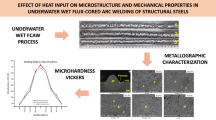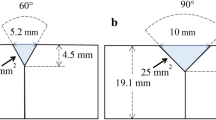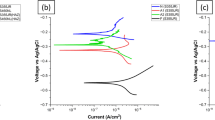Abstract
Recently, oil deposits were found in ever deeper waters. In this context, it is important to study the water depth effect on parameters in repair and maintenance operations of pipelines for extraction and/or transportation of crude oil, of which there is limited information in literature. This paper shows a study of the effect of the water depth on the microstructure and mechanical properties in joining structural steel welded in a marine environment in steels with a maximum CE (carbon equivalent) of 0.37 %. Wet welding coupons of steel ASTM A36 were joined by the manual metal arc welding (MMAW) process at depths of 10, 20, 30, and 40 m, using AWS Broco SoftTouch as filler metal (3.17 mm diameter) inside a simulation hyperbaric chamber. Image analysis was applied to welded coupons, with the aim to obtain the phase quantification and porosity as well as mechanical properties. The results show that there is an inverse relationship between the increase in depth at which the welding is performed and the mechanical properties, while the filler metal properties were kept constant. Microstructural changes vary as a function of the depth at which repair-maintenance is performed, with an increase in growing phase shift which is highly undesirable because of their brittleness and hardness.
Access this chapter
Tax calculation will be finalised at checkout
Purchases are for personal use only
Similar content being viewed by others
References
Verma K, Garg HK (2012) Underwater welding-recent trends and future scope. Int J Emerg Technol 3:115–1120
Joshi AM (2012) Underwater welding, vol 2. Indian Institute of Technology, Mumbai, pp 1–5
Pessoa ECP, Bracarense AQ, Zica EM, Liu S, Perez-Guerrero F (2006) Porosity variation along multipass underwater wet welds and its influence on mechanical properties. J Mater Process Technol 179:239–243
Johnson RL (1997) The efffect of water temperature on underbead cracking of underwater wet weldments. Naval Postgraduate School, Monterey
Hérnandez-Gutiérrez P (2011) Comportamiento microestructural de un acero API-5L-X52 soldados por el proceso MMAW en ambientes marinos. COMIMSA, Saltillo
Ballesteros-Hinojosa, A (2012) Analisis de la generacion de esfuerzos residuales en uniones soldadas en el acero API 5L-X65 aplicadas a diferentes profundidades en ambientes submarinos por el proceso de soldadura húmeda. COMIMSA, Saltillo
Quintana-Puchol R, Perdomo-Gonzalez L, Bracarense AQ, Pessoa ECP (2009) Thermodynamic considerations between pores formation and hydrostatic pressure during underwater wet welding. Soldagem Insp 14:161–169
Perez-Guerrero F, Liu S (2007) The mechanism of porosity formation in underwater wet welds. Defect Anal Mitigation 9:215–218
PEMEX. NRF-175-PEMEX-2013 (2013) Acero estructural para plataformas marinas, México (2013)
AWS (2004) Specification for carbon steel electrodes for shielded metal arc welding ANSI/AWS A5.1. American Welding Society, Miami
American Weilding Society (2010) Underwater welding code AWS D3.6M, 5th edn. American Welding Society, Miami
Dias-da-Silva WC, Ribeiro LF, Bracarense AQ, Pessoa ECP (2012) Effect of the hydrostatic pressure in the diffusible. In: Materials Technology; Polar and Arctic Sciences and Technology; Petroleum Technology Symposium, vol 6, pp 1–8
Babu SS (2004) The mechanism of acicular ferrite in weld deposits. Curr Opin Solid State Mater 8:267–278
ASTM A36 (1998) Standard specification for carbon structural steel. ASTM, United States
Author information
Authors and Affiliations
Corresponding author
Editor information
Editors and Affiliations
Rights and permissions
Copyright information
© 2017 Springer International Publishing Switzerland
About this chapter
Cite this chapter
Flores, M., Ruiz, J.J., Macı́as, F., Acevedo, J. (2017). Effect on the Microstructure and Mechanical Properties of the Structural Steel Welded in Marine Environment. In: Pérez Campos, R., Contreras Cuevas, A., Esparza Muñoz, R. (eds) Characterization of Metals and Alloys. Springer, Cham. https://doi.org/10.1007/978-3-319-31694-9_3
Download citation
DOI: https://doi.org/10.1007/978-3-319-31694-9_3
Published:
Publisher Name: Springer, Cham
Print ISBN: 978-3-319-31693-2
Online ISBN: 978-3-319-31694-9
eBook Packages: Chemistry and Materials ScienceChemistry and Material Science (R0)




